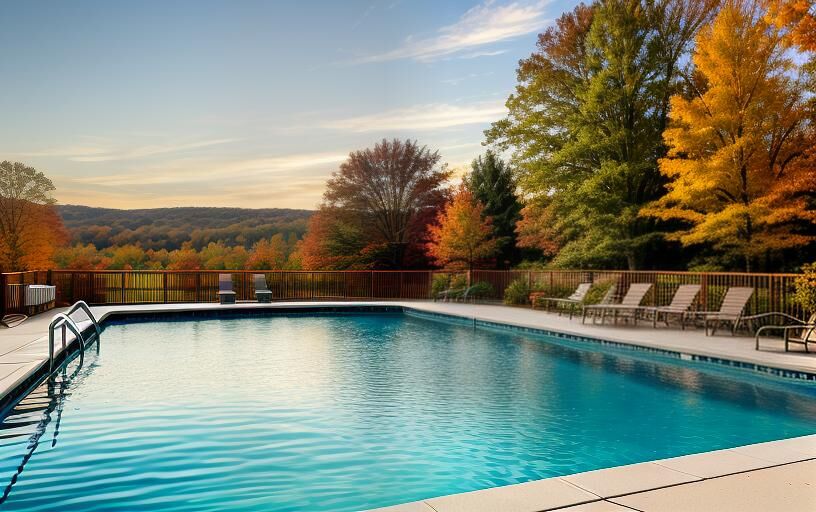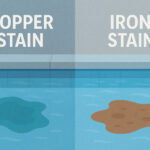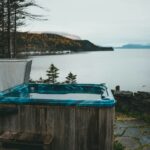Tennessee’s beautiful fall season brings cooler temperatures, stunning foliage, and a crucial transition period for your swimming pool. While you might be tempting to simply ignore your pool once summer ends, proper fall maintenance is essential for protecting your investment and ensuring an easy spring opening. This comprehensive guide will walk you through everything you need to know about preparing your Tennessee pool for the cooler months ahead.
🍂 Fall Pool Truth: “The work you do in September and October determines whether you’ll have crystal clear water next spring or a green, expensive mess to clean up.”
Understanding Tennessee’s Fall Pool Challenges
Temperature Swings Are Your Enemy
Tennessee’s fall weather can be unpredictable, with warm days followed by surprisingly cool nights. These temperature fluctuations affect your pool chemistry and can promote algae growth if you’re not prepared.
Leaf Debris Overload
Our gorgeous Tennessee maples, oaks, and hickories create a stunning fall display—and a potential nightmare for pool owners. Decomposing leaves can quickly turn your pool into a chemical nightmare.
🌡️ Tennessee Climate Reality: “A 70°F afternoon followed by a 45°F morning isn’t just uncomfortable—it’s the perfect storm for pool chemistry chaos.”
The Tennessee Fall Pool Timeline
Early Fall (September – Early October)
Water Temperature: 70-80°F
Swimming Status: Still enjoyable for many
Maintenance Focus: Transition preparations
Mid Fall (Mid-October – Early November)
Water Temperature: 60-70°F
Swimming Status: Occasional use only
Maintenance Focus: Intensive leaf management
Late Fall (November – December)
Water Temperature: Below 60°F
Swimming Status: Closed for most owners
Maintenance Focus: Winterization or reduced maintenance
Essential Fall Pool Maintenance Tasks
September: The Transition Month
Chemical Adjustments for Cooler Weather:
- Reduce chlorine production by 25-30% as bacteria growth slows
- Monitor pH more closely as temperature changes affect chemical balance
- Maintain alkalinity between 80-120 ppm (same as summer)
- Test water 2-3 times per week during temperature fluctuations
Equipment Preparations:
- Inspect heater if you plan to extend swimming season
- Clean filter thoroughly before leaf season begins
- Check pool cover for tears or damage
💡 Pro Tip: “Your pool heater can extend your swimming season by 4-6 weeks in Tennessee, but make sure it’s serviced before you need it!”
October: Peak Leaf Season
[Before/After Images: Pool before leaf fall vs pool covered in leaves, showing dramatic difference]
Leaf Management Strategy:
- Install leaf net over pool cover or water surface
- Skim daily during peak leaf drop
- Use tennis balls in skimmer baskets to absorb oils from leaves
- Brush pool walls twice weekly to prevent staining
- Run pump longer (12-14 hours) to handle increased debris
Chemical Monitoring:
- Shock weekly with granular chlorine to oxidize organic matter
- Add algaecide as preventive measure against cooler-weather algae
- Test phosphate levels as decomposing leaves can spike phosphates
November: Winterization Decisions
Two Paths for Tennessee Pool Owners:
Option 1: Full Winterization
- Lower water level below skimmer and return jets
- Add winterizing chemicals for long-term protection
- Drain equipment to prevent freeze damage
- Install winter cover for complete protection
Option 2: Reduced Maintenance
- Keep pool operational with reduced chemical levels
- Run pump 4-6 hours daily to prevent freezing
- Maintain basic chemical balance for spring readiness
- Use solar cover to retain heat and reduce debris
❄️ Tennessee Winter Strategy: “Most Tennessee pools can avoid full winterization if you’re willing to maintain basic operations through winter.”
Chemical Adjustments for Fall
[Diagram: Seasonal chemical adjustment chart showing summer vs fall chemical needs]
Chlorine Management
Summer Levels: 2-3 ppm
Fall Levels: 1-2 ppm
Why: Cooler water reduces bacteria multiplication, requiring less sanitizer
pH Stability
Target Range: 7.2-7.6 (unchanged)
Fall Challenge: Temperature fluctuations cause more pH swings
Solution: Test more frequently, make smaller adjustments
Shock Treatments
Summer Frequency: Weekly during heavy use
Fall Frequency: Bi-weekly, or after heavy leaf debris
Purpose: Oxidize organic matter from decomposing leaves
Algaecide Application
Fall Strategy: Preventive rather than reactive
Frequency: Every 2 weeks through October
Type: Non-foaming algaecide works best in cooler weather
Leaf Management: The Tennessee Pool Owner’s October Challenge
Prevention Strategies
- Leaf blower routine: Clear deck and surrounding area daily
- Tree trimming: Remove overhanging branches before leaf drop
- Barrier installation: Temporary fencing to redirect wind-blown leaves
Active Removal Techniques
- Large leaf net: Essential tool for efficient removal
- Leaf rake: For stubborn leaves that sink to bottom
- Pool vacuum: Weekly vacuuming during peak season
- Skimmer basket upgrade: Larger capacity baskets reduce emptying frequency
Chemical Consequences of Leaves
What happens when leaves decompose:
- pH drops due to organic acids
- Phosphate levels spike feeding algae growth
- Chlorine demand increases to oxidize organic matter
- Water staining from tannins in leaves
🍁 Leaf Season Reality Check: “One day of neglecting leaf removal can create a week’s worth of chemical rebalancing work.”
Equipment Winterization for Tennessee
Pool Pump and Filter
If Winterizing:
- Drain pump basket and remove all water
- Backwash filter one final time
- Remove drain plugs and store indoors
- Add pool antifreeze to pump if needed
If Keeping Operational:
- Reduce run time to 4-6 hours daily
- Install freeze protection if temperatures drop below 32°F
- Clean filter monthly instead of weekly
Heater Maintenance
End-of-Season Care:
- Professional service recommended before shutdown
- Drain all water from heat exchanger
- Cover air intake/exhaust to prevent debris entry
- Schedule spring startup service in advance
Plumbing Protection
Critical for Tennessee’s Freeze Risk:
- Blow out lines with compressed air or shop vacuum
- Add antifreeze to skimmer and return lines
- Install gizzmos in skimmers to prevent cracking
- Insulate exposed pipes in equipment area
Pool Cover Selection and Installation
Safety Covers (Premium Choice)
Benefits: Maximum protection, safety compliance, long-term durability Cost: $1,200-3,000 for average Tennessee pool
Best for: Families with children, long-term pool protection
Winter Covers (Standard Choice)
Benefits: Good protection, affordable, easy installation
Cost: $100-400 for average pool
Best for: Budget-conscious owners, seasonal use
Solar Covers (Maintenance Mode)
Benefits: Heat retention, reduced evaporation, easy handling
Cost: $50-200
Best for: Pools staying operational through fall
Tennessee Cover Considerations
- Wind resistance: Essential for our fall weather
- UV protection: Prevents cover degradation
- Drainage system: Handles Tennessee’s winter precipitation
- Professional installation: Recommended for safety covers
Fall Pool Problems and Solutions
Cloudy Water After Temperature Drop
Cause: Rapid temperature change affects chemical balance Solution:
- Test all chemical levels immediately
- Adjust pH to 7.2-7.4 range
- Shock pool with granular chlorine
- Run pump continuously until clear
Green Tint from Decomposing Leaves
Cause: Organic matter and phosphates promoting algae Solution:
- Remove all visible debris
- Test and adjust pH
- Shock pool heavily (double normal dose)
- Add algaecide treatment
- Brush all surfaces thoroughly
Equipment Freeze Damage Prevention
Warning Signs: Temperatures dropping to 32°F or below
Immediate Actions:
- Run pump continuously during freeze
- Keep water moving through all equipment
- Open all valves to prevent trapped water
- Consider adding pool heater for equipment protection
🚨 Freeze Warning: “In Tennessee, that ‘light freeze’ can cause thousands in equipment damage if your pool isn’t prepared.”
Money-Saving Fall Maintenance Tips
Chemical Purchasing Strategy
- Buy spring chemicals now: 30-40% savings during fall sales
- Stock up on shock: Granular chlorine stores well for 2+ years
- Winterizing chemical kits: Often cheaper than individual purchases
DIY vs Professional Services
DIY-Friendly Tasks:
- Basic chemical balancing
- Leaf removal and skimming
- Filter cleaning
- Cover installation (standard covers)
Professional Recommended:
- Equipment winterization
- Heater service and repair
- Safety cover installation
- Plumbing winterization
Equipment Maintenance Savings
- Off-season equipment service: 20-30% lower rates
- Preventive maintenance: Avoid expensive spring repairs
- Bulk filter purchases: Stock up during fall sales
💰 Fall Savings Secret: “The money you spend on proper fall maintenance is typically 1/3 the cost of spring cleanup and repairs.”
Tennessee Regional Considerations
East Tennessee (Mountain Region)
- Earlier freeze risk: Begin winterization by mid-November
- Higher elevation effects: More dramatic temperature swings
- Leaf management: Extended season due to elevation differences
Middle Tennessee (Nashville Area)
- Moderate climate: Can often maintain pools through December
- Urban heat island: Cities stay warmer, extending season
- Wind patterns: Fall storms require secure cover installation
West Tennessee (Memphis Region)
- Later freeze dates: Pool season can extend into January
- Higher humidity: Affects chemical stability
- Storm season: Fall storms may require additional debris management
Creating Your Personal Fall Maintenance Schedule
Week 1-2 (Early September)
- Reduce chemical levels gradually
- Inspect and repair equipment
- Order winterization supplies
- Plan leaf management strategy
Week 3-4 (Late September)
- Install leaf protection
- Begin increased skimming routine
- Test water more frequently
- Prepare backup equipment
October (Peak Activity)
- Daily leaf removal
- Weekly shock treatments
- Monitor chemical balance closely
- Begin equipment winterization prep
November (Transition)
- Make winterization decision
- Install pool cover
- Reduce maintenance schedule
- Prepare equipment for winter
Safety Considerations for Fall Pool Maintenance
Slippery Deck Hazards
- Wet leaves create slip risks: Clear deck before maintenance
- Morning frost: Wait for ice to melt before working
- Pool cover condensation: Use non-slip shoes
Chemical Handling in Cool Weather
- Storage temperature: Keep chemicals in heated storage area
- Mixing considerations: Cold water affects chemical dissolution
- Ventilation: Ensure adequate airflow when adding chemicals
Equipment Safety
- Electrical hazards: Increased risk with fall moisture
- Sharp tools: Leaf rakes and nets require careful handling
- Heavy lifting: Pool covers and equipment require proper technique
Preparing for Spring Success
Documentation Strategy
- Photo documentation: Before and after shots for spring reference
- Chemical log: Record all treatments and adjustments
- Equipment notes: Document any issues or needed repairs
- Cover installation date: Important for removal timing
Spring Preparation Tasks
- Schedule equipment service: Book early for better rates
- Order opening chemicals: Avoid spring rush pricing
- Plan equipment upgrades: Research winter equipment deals
- Landscape planning: Consider pool area improvements
📋 Organization Tip: “A detailed fall maintenance log makes spring opening 10x easier and helps identify recurring issues.”
Conclusion
Tennessee’s fall season offers the perfect opportunity to protect your pool investment while enjoying some of the most beautiful weather of the year. The key to successful fall pool maintenance isn’t complicated—it’s consistent attention to the changing conditions and proactive preparation for winter.
By following this comprehensive fall maintenance guide, you’ll not only protect your pool through the cooler months but also set yourself up for an easy, cost-effective spring opening. Remember, the extra effort you put in now will save you time, money, and frustration when swimming season returns.
🏊♀️ Final Fall Wisdom: “A well-maintained pool in fall is like money in the bank—it pays dividends when you’re ready to swim again.”
Whether you choose full winterization or reduced maintenance through Tennessee’s mild winters, the most important thing is having a plan and sticking to it. Your future self will thank you when spring arrives and your pool is ready for another season of enjoyment.
Have specific questions about your pool’s fall care? Drop us a comment below—we love helping Tennessee pool owners protect their investment!







